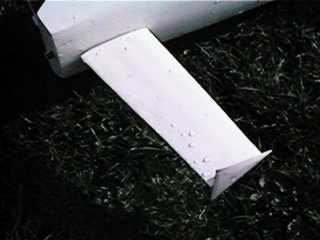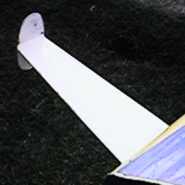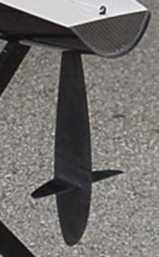|
 I
photographed Ken Coles' winged rudder on an IOM some time ago, a simple delta shape
at the base of the rudder. It didn't seem to do very much, but Ken
said it helped prevent nose-diving on the run when over-pressed. I
photographed Ken Coles' winged rudder on an IOM some time ago, a simple delta shape
at the base of the rudder. It didn't seem to do very much, but Ken
said it helped prevent nose-diving on the run when over-pressed.
The idea has taken off in full-size sailing, in the International Moth and
the International 14 classes in particular. Apparently the winged rudder
does indeed help prevent nose-diving. Thing is, in these classes the crew
are all over the boat keeping it pretty level, so the wings can work exactly as
required. For the IOM or RM, the usefulness of the wings is reduced on the
beat, and it is likely they add considerable drag. Ken is more optimistic:
Winglets may reduce Induced drag, and make the keel more efficient -
perhaps allowing a smaller rudder and hence reducing the drag from that
source. Some relevant Web sites include hanleyinnovations.com/sailaero,
vacantisw.com/foildesign, and simarnet.com/yacht-keels.
The ideal angle of incidence of the wings is a question that isn't easy to
answer. My first guess is that something around -1 or -2 degrees is
needed, and that this would be a problem for a wide-beamed boat, because the
drag would be too serious as it trimmed bows-down, adding to the angle of
attack. So it would be a narrow-beamed hull that would have most chance to
benefit. Then, you'd really want to be able to adjust the incidence with a
third servo, so the RM or 10R class would be the best bet.
These two shots are of the rudders on an RC "40" class
catamaran. Top surface of the wing is flat, while the bottom surface has a
curved, aerofoil section.
 
The other effect on the beat is that the boat would most likely not be able
to point so well. That is, it would have lee helm. This would be a
bad idea, until the wind got up so much that you were developing serious weather
helm -- and then the wings would help, counteracting that. So if you
insisted on sailing with your "A" rig when you really should be in
"B", a winged rudder might be just the ticket.
 Here
is Eric Arndt's winged rudder on his Marblehead. Looks really neat.
E-mail him at "Ericarndt@aol.com"
if you'd like to know more. He tells me the results are
"sensational". Here
is Eric Arndt's winged rudder on his Marblehead. Looks really neat.
E-mail him at "Ericarndt@aol.com"
if you'd like to know more. He tells me the results are
"sensational".
Brett McCormack has sent me some comments on winged rudders:
I've tried winged rudders on IOM, on a Highlander hull and also on a
Bantock Rythym which was notorious for diving, It completely transformed
the Rythym, so it was able to carry top suit much longer than before. The foil
used was 40mm across, 20mm wide and 4mm thick, a symetrical section set at 0
degrees.
I have used rudder foils on International moths for some years (it is
common practice in the class) hence the reason to try them on models. The
reason they are not used more in full size is that most yachts carry spinakers
which you can use to keep the bow up, but this is not so on a model or
Moth. I believe that narrow hulls will benefit more than wider
ones. But, like I said, I have done no formal research.
Gordon Price has sent me some comments on winged rudders as well:
I noted the bit on winged rudders. International 14s use them when going up
wind to lift the stern significantly up out the water and cant the boat
forward much like a TS2 does when it heels. I believe the 14 boys are trying
to reduce wetted area and keep the rig upright rather than suffer the rake
back you get due to the windage drag when going up wind. They may also be
using it to control weather helm like the TS2 - as you move the rig forward
and fin back by lifting the stern. The international 14 implementation is
variable by the crew and they no doubt use it the other way when going
downwind. For a IOM a deep light rudder with a small heavy wing at the bottom
(75 gm all up!) would be an interesting experiment. A removable one would be
the way to go to evaluate the concept.
2008-12-08 | 